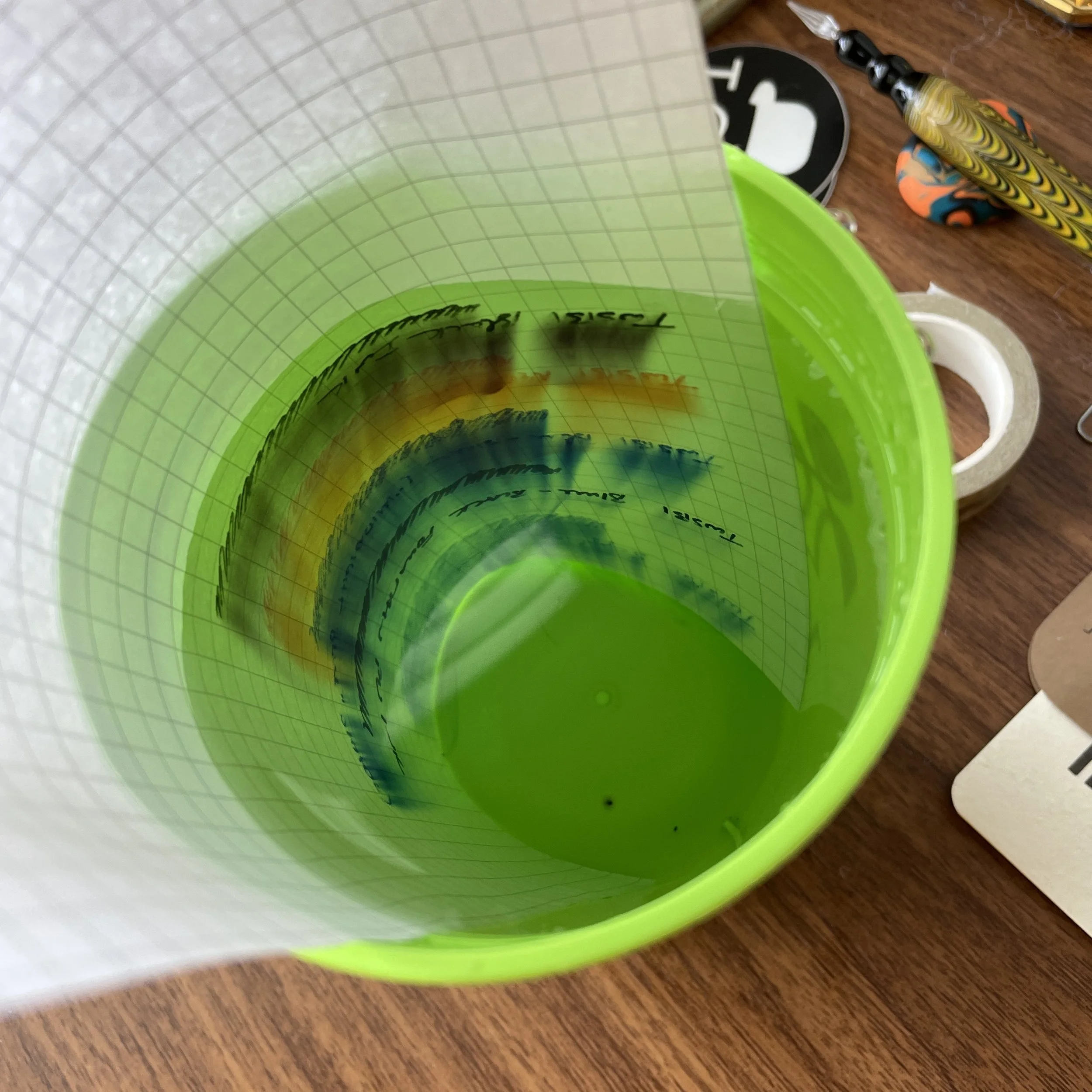I don’t do as many ink reviews as some bloggers, and when I do, it’s mainly a high-level review of (1) how I like the color, and (2) how the ink behaves on the paper that I use on a day-to-day basis, meaning whether it feathers, bleeds, or takes forever to dry. I typically don’t review properties such as the degree of lightfastness (i.e., whether the ink will fade if exposed to sunlight over a long period of time) or water-resistance. So why not? First of all, I don’t have the scientific background or personal experience necessary to make an informed judgment much beyond “I splashed some water on this page of writing and it did/did not smear.” Second, these properties aren’t as important to me as being able to get the ink down on the page with as little fuss as possible. I don’t necessarily need my notes and drafts to be archivally bulletproof, and if I do, I’ll take notes in ballpoint or pencil, or will type them up for electronic storage.
Testing inks at pen club in “everyday” situations.
That said, I’ve actually been fairly surprised at the water-resistance of many modern fountain pen inks, even those that don’t advertise themselves as “waterproof” or “bulletproof.” You may have seen some pictures I posted on my Instagram account from last week’s meeting of the Middle Tennessee Fountain Pen Club, where several of us were comparing shades of dark green, and I got curious and splashed some water (not beer) on my writing samples. All five inks actually held up fairly well, with two qualifying as what I would call “waterproof” for my purposes. Here, the Kakimori pigmented ink held up the best (as pigmented ink should do); Noodler’s “Zhivago” came in second (it’s “semi-bulletproof” after all), followed by Cross Black, Birmingham Inks Ancho Chili Pepper, and Diamine Salamander, all of which remained highly legible even if some of the color washed out.
The results from water testing at pen club. Paper used in this test is Write Notepads Dot Grid Paper.
Water testing TWSBI Inks under “less ordinary” circumstances
Similarly, a while back I did a “soak test” of all five TWSBI standard inks and found that the Blue-Black was more or less completely waterproof, while the Black and Midnight Blue showed high levels of water-resistance. This is a far cry from when I first started getting into the pen hobby, and my beloved Waterman inks would essentially wash off the page if I got caught in a rainstorm or spilled a drink.
Results of my TWSBI waterproof testing from a while back. Testing paper is Rhodia.
Suggestions for Waterproof and Water-Resistant Inks
While I still wouldn’t expect fountain pens to be the best choice for signing legal documents or in situations like drawings or technical plans where you absolutely don’t want the ink to run, in light of this experiment I remain relatively unconcerned about the water-resistance of my fountain pen inks, expecting that most of them will remain “legible enough” in the event of a spill. That said, if I want to sign a legal document or am in some other situation where I do want a waterproof (or “highly water-resistant”) ink, here are my favorites:
TWSBI Blue-Black. A great classic steel-blue color, and water-resistant due to iron-gall content.
Pilot Blue-Black. Another classic blue-black ink with high water-resistance that behaves well in most pens. If you shop internationally, you can sometimes order this ink in very large bottles.
Sailor Kiwa-Guro. A pigmented black ink that dries to a matte finish. Blue and Blue-Black pigmented inks are also available from Sailor.
TWSBI Black. For a standard black ink, this ink surprised me with how well it held up when soaked in a glass of water. If you’re looking for a workhorse black, why not choose one where you won’t have to worry if your notebook gets wet?
Noodler’s Zhivago. Not quite as waterproof as Noodler’s “Bulletproof Black,” but I find that this one behaves better, and is a nice green-black shade.
Platinum Carbon Black. Another pigmented ink that’s a favorite of artists as well as writers.
Please note that this is absolutely NOT an exhaustive list of all the “waterproof” fountain pen inks available. Noodler’s makes an entire line of “bulletproof” and “eternal” inks, and companies such as Kakimori, Platinum, and Rohrer & Klingner all make iron-gall, pigmented and “document” inks expressly intended for maximum water-resistance. Also, most permanent inks will need to be regularly cleaned out of your pens every couple of weeks, if not more frequently. (As long as an ink is intended for use in fountain pens, it most likely will not harm your pens, per se, but you may start to have clogging and hard-starting issues if you leave these inks in a pen for a long time.)
This post does not contain paid third-party affiliate links, and unless otherwise noted, all links are to the T.G.S. Curated Shop, an authorized retailer of all brands we carry. By shopping with us directly, you are supporting original content, pen reviews, pen show events, etc. from The Gentleman Stationer. If you would like to support us even further, please consider checking out the T.G.S. Patreon Program, which offers access to online meetups, exclusive discounts and pre-orders, and more!
